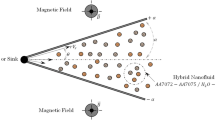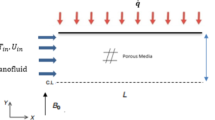Abstract
Numerical simulations of titanium dioxide nanoparticle synthesis in planar, non-premixed diffusion flames are performed. Titania is produced by the oxidation of titanium tetrachloride using a methane–air flame. The flow field is obtained using the two-dimensional Navier–Stokes equations. The methane–air flame and oxidation of titanium tetrachloride are modeled via one-step reactions. Evolution of the particle field is obtained via a nodal method which accounts for nucleation, condensation, coagulation, and coalescence with finite-rate sintering. The modeling of finite-rate sintering is accomplished via the use of uniform primary-particle size distribution. Simulations are performed at two different jet-to-co-flow velocity ratios as well as with finite-rate and instantaneous sintering models. In doing so we elucidate the effect of fluid mixing and finite-rate sintering on the particle field. Results show that highly agglomerated particles are found on the periphery of the eddies, where the collisions leading to nanoparticle coagulation occur faster than nanoparticle coalescence.









Similar content being viewed by others
References
Arabi-katbi OI, Pratsinis SE, Morrison PW, Megaridis CM (2001) Monitoring the flame synthesis of TiO2 particles by in-situ FTIR spectroscopy and thermophoretic sampling. Combust Flame 124:560–572
Artelt C, Schmid HJ, Peukert W (2003) On the relevance of accounting for the evolution of the fractal dimension in aerosol process simulations. J Aerosol Sci 34:511–534
Beaucage G, Kammler HK, Mueller R, Strobel R, Agashe N, Pratsinis SE, Narayanan T (2004) Probing the dynamics of nanoparticle growth in a flame using synchrotron radiation. Nat Mater 3(6):370–373
Bilger RW (1988) The structure of turbulent nonpremixed flames. In: Proceedings of 22nd symposium (international) on Combustion. The Combustion Institute, Pittsburgh, PA, pp 475–488
Biswas P, Wu CY, Zachariah MR, McMillin B (1997) Characterization of iron oxide-silica nanocomposites in flames: part II: comparison of discrete-sectional model predictions to experimental data. J Mater Res 12:714–723
Colucci PJ, Jaberi FA, Givi P, Pope SB (1998) Filtered density function for large eddy simulation of turbulent reacting flows. Phys Fluids 10(2):499–515
Friedlander KS (2000) Smoke, dust and haze: fundamentals of aerosol dynamics. Oxford University Press, New York
Garrick SC, Lehtinen KEJ, Zachariah MR (2001) Modeling and simulation of nanoparticle coagulation in high Reynolds number incompressible flows. In: Proceedings of Joint US Sections Meeting of the Combustion Institute, Oakland, CA
Garrick SC, Lehtinen KEJ, Zachariah MR (2006) Nanoparticle coagulation via a Navier–Stokes/nodal methodology: evolution of the particle field. J Aerosol Sci 37(5):555–576
Gelbard F, Seinfeld JH (1980) Simulation of multicomponent aerosol dynamics. J Colloid Interface Sci 78:485–501
Gelbard F, Tambour Y, Seinfeld JH (1980) Sectional representations for simulating aerosol dynamics. J Colloid Interface Sci 76:541–556
George AP, Murley RD, Place ER (1973) Formation of TiO2 aerosol from the combustion supported reaction of TiCl4 and O2. Symp Faraday Soc 70:63–76
Givi P (1989) Model free simulations of turbulent reactive flows. Prog Energy Combust Sci 15:1–107
Hinds WC (1999) Aerosol technology: properties, behavior and measurement of airborne particles, 2nd edn. Wiley, New York
Hounslow M, Ryall R, Marshall V (1988) Discretized population balance for nucleation, growth, and aggregation. AICHE J 34(11):1821–1832
Jaberi FA, Colucci PJ, James S, Givi P, Pope SB (1999) Filtered mass density function for large eddy simulation of turbulent reacting flows. J Fluid Mech 401:85–121
James S (1998) Realistic chemistry in large scale numerical simulations of methane diffusion flames. Ph.D. Thesis, Department of Mechanical and Aerospace Engineering, State University of New York at Buffalo, Buffalo, NY
James S, Jaberi FA (2000) Large scale simulations of two-dimensational nonpremixed methane jet flames. Combust Flame 123:465–487
Jeong JI, Choi M (2003) Analysis of non-spherical polydisperse particle growth in a two-dimensional tubular reactor. J Aerosol Sci 34:713–732
Johannessen T, Pratsinis SE, Livbjerg H (2001) Computational analysis of coagulation and coalescence in the flame synthesis of titania particles. Powder Technol 118:242–250
Khakpour M (2004) The effects of differential diffusion and flow-field on nanoparticle coagulation. M.S. Thesis, University of Minnesota, Minneapolis, MN
Kuo KK, Rivera JD (eds) (2007) Advancements in energetic materials and chemical propulsion. Begell House Inc., New York
Lehtinen KEJ, Zachariah MR (2001) Self-preserving theory for the volume distribution of particles undergoing Brownian coagulation. J Colloid Interface Sci 242:314–318
Lehtinen KEJ, Zachariah MR (2002) Energy accumulation in nanoparticle collision and coalescence processes. J Aerosol Sci 33:357–368
Miller S, Garrick SC (2004) Nanoparticle coagulation in a planar jet. Aerosol Sci Technol 38(1):79–89
Modem S, Garrick SC (2003) Nanoparticle coagulation in a temporal mixing layer: mean and size-selected images. J Visualization 6(3):333–342
Modem S, Garrick SC, Zachariah MR, Lehtinen KEJ (2002) Direct numerical simulation of nanoparticle coagulation in a temporal mixing layer. In: Proceedings of the 29th symposium (international) on combustion. The Combustion Institute, Pittsburgh, PA, pp 1071–1077
Moody EG, Collins LR (2003) Effect of mixing on the nucleation and growth of titania particles. Aerosol Sci Technol 37(5):403–424
Mungal MG, Dimotakis PE (1984) Mixing and combustion with low heat release in a turbulent mixing layer. J Fluid Mech 148:349–382
Park S, Rogak SN (2003) A one-dimensional model for surface coagulation, sintering, and surface growth of aerosol agglomerates. Aerosol Sci Technol 37(12):947–960
Park S, Rogak SN (2004) A novel fixed-sectional model for the formation and growth of aerosol agglomerates. J Aerosol Sci 35(11):1385–1404
Pratsinis SE (1989) Particle production by gas-to-particle conversion in turbulent flows. J Aerosol Sci 20(8):1461–1464
Pratsinis SE (1998) Flame aerosol synthesis of ceramic powders. Prog Energy Combust Sci 24:197–219
Pyykönen J, Jokiniemi J (2000) Computational fluid dynamics based sectional aerosol modelling schemes. J Aerosol Sci 31(5):531–550
Rao N, Girshick S, Heberlein J, McMurry P, Jones S, Hansen D, Michael B (1995) Nanoparticle formation using a plasma expansion process. Plasma Chem Plasma Proc 15:581
Schwade B, Roth P (2003) Simulation of nano-particle formation in a wall-heated aerosol reactor including coalescence. J Aerosol Sci 34:339–357
Settumba N, Garrick SC (2003) Direct numerical simulation of nanoparticle coagulation in a temporal mixing layer via a moment method. J Aerosol Sci 34:149–167
Settumba N, Garrick SC (2007) Modeling and simulation of nano-aluminum synthesis in a plasma reactor. In: Kuo KK, Rivera JD (eds) Advancements in energetic materials and chemical propulsion. Begell House Inc., New York, pp 643–655
Steinberger CJ, Vidoni TJ, Givi P (1993) The compositional structure and the effects of exothermicity in a nonpremixed planar jet flame. Combust Flame 94:217–232
Tsantilis S, Pratsinis SE (2000) Evolution of primary and aggregate particle-size distributions by coagulation and sintering. AICHE J 46:407–415
Tsantilis S, Kammler HK, Pratsinis SE (2002) Population balance modeling of flame synthesis of titania nanoparticles. Chem Eng Sci 57:2139–2156
Wang G, Garrick SC (2005) Modeling and simulation of titania synthesis in two-dimensional methane–air flames. J Nano Res 7:621–632
Wang G, Garrick SC (2006) Modeling and simulation of titania formation and growth in temporal mixing layers. J Aerosol Sci 37(4):431–451
Wegner K, Pratsinis SE (2003) Nozzle-quenching process for controlled flame synthesis of titania nanoparticles. AIChE J 49(7):1667–1675
Williams FA (1989) Structure of flamelets in turbulent reacting flows and influences of combustion on turbulence fields. In: Borghi R, Murthy SNB (eds) Turbulent reactive flows. Lecture notes in engineering, vol 40. Springer, New York, pp 195–212
Williams J, Lansdown R, Sweitzer R, Romanowski M, LaBell R, Ramaswami R, Unger E (2003) Nanoparticle drug delivery system for intravenous delivery of topoisomerase inhibitors. J Control Release 91(1):167–172
Wooldridge MS (1998) Gas-phase combustion synthesis of particles. Prog Energy Combust Sci 24:63–87
Xiong Y, Pratsinis SE (1993) Formation of agglomerate particles by coagulation and sintering—part I. A two-dimensional solution of the population balance equation. J Aerosol Sci 24(3):283–300
Yang G, Biswas P (1997) Study of the sintering of nanosized titania agglomerates in flames using in situ light scattering measurement. Aerosol Sci Technol 27:507–521
Zachariah M, Chin B, Semerjian H, Katz J (1989) Silica particle synthesis in a counter flow diffusion flame reactor. Combust Flame 78:287
Acknowledgments
This work was supported by the Minnesota Supercomputing Institute.
Author information
Authors and Affiliations
Corresponding author
Rights and permissions
About this article
Cite this article
Garrick, S.C., Wang, G. Modeling and simulation of titanium dioxide nanoparticle synthesis with finite-rate sintering in planar jets. J Nanopart Res 13, 973–984 (2011). https://doi.org/10.1007/s11051-010-0097-x
Received:
Accepted:
Published:
Issue Date:
DOI: https://doi.org/10.1007/s11051-010-0097-x




